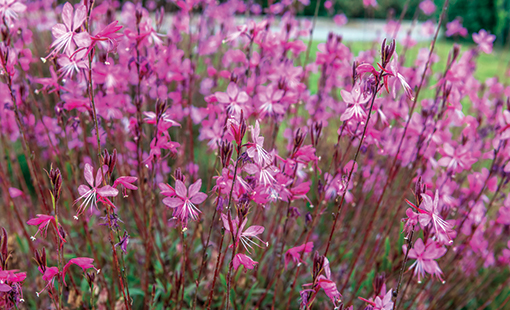
Growing Gaura
Gaura is a low-maintenance perennial that may give coneflower a run for its money in the cultivated wildflower popularity contest. In fact, the origin of its name comes from the Greek word gauros, which means superb. Also known as wandflower, whirling butterfly, and bee blossom, gaura can range from 15 inches to 4 feet tall, but most new cultivars are bred to be compact and container-friendly.
One of the best features of gaura plants is the long bloom time, much longer than most perennials. The heaviest blooming occurs in early summer, but you can expect flushes of flowers to recur throughout the summer and into fall in USDA growing zones 5 through 9. They are best planted in the spring or fall. Gaura foliage is lance-shaped and often tinged with pink, cream, or gold, depending on the variety. Wiry flower stems bear many 1-inch flowers with four petals each. Flowers are white, pink or a combination of the two.
Care
Gaura is a low-maintenance plant that is a good choice for novice gardeners. Its waving wands dotted with dozens of pinkish flowers don’t stop blooming in triple-digit temperatures or in dry weather that turns lawns crisp.
The airy texture and form of gaura make them lovely accent plants in a mixed perennial border. You can plant masses of them in the wildflower garden, where they will demonstrate how they got the nickname “whirling butterflies” as they dance in the breeze. Keep in mind that the long taproot that makes gaura so drought-tolerant also makes it difficult to transplant successfully, so choose your planting site carefully.
Gaura plants may flop over in the garden, and while staking is always an option, you can use supportive companion plants that will keep the flower spikes out of the mud. Rigid, upright flowers like yarrow, ‘Autumn Joy’ sedum or liatris have similar growing conditions and blooming times. A trio of butterfly weed, globe thistle and gaura is a stunning combination in a dry garden that will bring the pollinators by the score.
Light
Gaura thrives and blooms best in full sun but will tolerate some afternoon shade, particularly in hot climates.
Soil
Along with plenty of sunshine, excellent drainage is the key to success with gaura. They aren’t the longest-lived perennials in any case, and wet winter soil will kill these drought-tolerant natives. Amend the soil with a mix of compost and grit or, better yet, plant them in raised beds. Space the plants at least 12 inches apart, and plant in groups of three or five plants for maximum impact.
Water
Water gaura infrequently but deeply to help the plants establish their deep roots.
Temperature & Humidity
Gaura tolerates extreme heat and humidity as well as cold, which makes it suitable to be grown in a wide range of climate zones.
Fertilizer
Gaura thrives in poor soil and doesn’t need supplemental flower fertilizer. Too much manure or fertilizer can make the plant floppy.
Gaura (Wandflower) Varieties
There are several beautiful cultivated varieties to choose from, including:
- ‘Corrie’s Gold’: The gold in this plant refers not to the flowers, but to the marvelous variegated foliage. Flowers are white tinged with pink.
- ‘Crimson Butterflies’: Bright pink flowers on red stems hover above burgundy foliage. Partner them with blue or green-flowering plants for a head-turning combination.
- ‘Passionate Rainbow’: As if the pink flower wands weren’t enough, the foliage is also edged in pink.
- ‘Siskiyou Pink’: These showy rose-pink flowers are the most common variety in the trade.
- ‘Sparkle White’: Dainty white flowers are tinged with pink in this elegant gaura variety. It received the Fleuroselect Gold Medal in 2014 for its beauty and garden performance.
Pruning
Cutting back the stems of gaura after the first main bloom will encourage a tidy plant and spur repeat blooming.
Potting
If you can’t get your gaura plants to overwinter reliably because of heavy, waterlogged soil or below-average temperatures, the long-flowering season and compact growth habit of gaura make it a worthwhile investment as a container plant.
To accommodate the plant’s tap root, use a pot that is 12 inches deep and 10 inches in diameter and has good-size drainage holes because the roots don’t like to sit in soggy soil. For the potting medium, use an all-purpose potting mix.
Common Pests
Gaura plants don’t suffer from many pests, but can be vulnerable to aphids in the early summer, which you can spray with a hose or insecticidal soap.
You can make your flower garden less welcoming to these pests by removing dead plant matter that insects use to overwinter in at the end of the growing season, keeping your flowerbeds weeded, and attracting parasitic wasps with a companion planting of sweet alyssum.
FAQ
-
Is Gaura invasive?
As a plant that is native to North America, it is not considered invasive.
-
Is gaura an annual?
Gaura is a perennial but if your climate is too cold for it to last through the winter, you can grow it as an annual flower.
-
Do you cut back gaura in the fall?
It’s recommended to cut gaura back to the ground in the fall, which also minimizes the risk of any pests overwintering in the debris and coming back next year.
Information courtesy of TheSpruce.com

 Adams Fairacre Farms
Adams Fairacre Farms